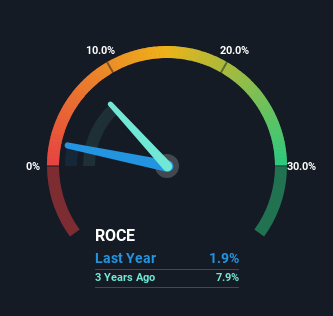- Denmark
- /
- Electrical
- /
- CPSE:VWS
Returns On Capital Signal Tricky Times Ahead For Vestas Wind Systems (CPH:VWS)
If you're not sure where to start when looking for the next multi-bagger, there are a few key trends you should keep an eye out for. Firstly, we'd want to identify a growing return on capital employed (ROCE) and then alongside that, an ever-increasing base of capital employed. Ultimately, this demonstrates that it's a business that is reinvesting profits at increasing rates of return. However, after investigating Vestas Wind Systems (CPH:VWS), we don't think it's current trends fit the mold of a multi-bagger.
Return On Capital Employed (ROCE): What Is It?
For those who don't know, ROCE is a measure of a company's yearly pre-tax profit (its return), relative to the capital employed in the business. To calculate this metric for Vestas Wind Systems, this is the formula:
Return on Capital Employed = Earnings Before Interest and Tax (EBIT) ÷ (Total Assets - Current Liabilities)
0.019 = €163m ÷ (€23b - €15b) (Based on the trailing twelve months to September 2024).
Therefore, Vestas Wind Systems has an ROCE of 1.9%. In absolute terms, that's a low return and it also under-performs the Electrical industry average of 13%.
View our latest analysis for Vestas Wind Systems

Above you can see how the current ROCE for Vestas Wind Systems compares to its prior returns on capital, but there's only so much you can tell from the past. If you're interested, you can view the analysts predictions in our free analyst report for Vestas Wind Systems .
How Are Returns Trending?
On the surface, the trend of ROCE at Vestas Wind Systems doesn't inspire confidence. To be more specific, ROCE has fallen from 19% over the last five years. Meanwhile, the business is utilizing more capital but this hasn't moved the needle much in terms of sales in the past 12 months, so this could reflect longer term investments. It may take some time before the company starts to see any change in earnings from these investments.
On a separate but related note, it's important to know that Vestas Wind Systems has a current liabilities to total assets ratio of 64%, which we'd consider pretty high. This effectively means that suppliers (or short-term creditors) are funding a large portion of the business, so just be aware that this can introduce some elements of risk. While it's not necessarily a bad thing, it can be beneficial if this ratio is lower.
What We Can Learn From Vestas Wind Systems' ROCE
Bringing it all together, while we're somewhat encouraged by Vestas Wind Systems' reinvestment in its own business, we're aware that returns are shrinking. And in the last five years, the stock has given away 16% so the market doesn't look too hopeful on these trends strengthening any time soon. In any case, the stock doesn't have these traits of a multi-bagger discussed above, so if that's what you're looking for, we think you'd have more luck elsewhere.
If you'd like to know about the risks facing Vestas Wind Systems, we've discovered 2 warning signs that you should be aware of.
While Vestas Wind Systems isn't earning the highest return, check out this free list of companies that are earning high returns on equity with solid balance sheets.
New: Manage All Your Stock Portfolios in One Place
We've created the ultimate portfolio companion for stock investors, and it's free.
• Connect an unlimited number of Portfolios and see your total in one currency
• Be alerted to new Warning Signs or Risks via email or mobile
• Track the Fair Value of your stocks
Have feedback on this article? Concerned about the content? Get in touch with us directly. Alternatively, email editorial-team (at) simplywallst.com.
This article by Simply Wall St is general in nature. We provide commentary based on historical data and analyst forecasts only using an unbiased methodology and our articles are not intended to be financial advice. It does not constitute a recommendation to buy or sell any stock, and does not take account of your objectives, or your financial situation. We aim to bring you long-term focused analysis driven by fundamental data. Note that our analysis may not factor in the latest price-sensitive company announcements or qualitative material. Simply Wall St has no position in any stocks mentioned.
About CPSE:VWS
Vestas Wind Systems
Engages in the design, manufacture, installation, and services of wind turbines the United States, Denmark, and internationally.
Outstanding track record and good value.
Similar Companies
Market Insights
Community Narratives




